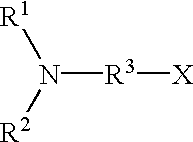Lubricant for conveyor system
- Summary
- Abstract
- Description
- Claims
- Application Information
AI Technical Summary
Problems solved by technology
Method used
Image
Examples
example 1
Lubricity Improvement with a Composition Containing Pluronic F108 and Fatty Acid
The following table shows two compositions that were prepared by admixing the listed ingredients in the appropriate wt.-% as shown. Formula A includes a polyalkylene glycol polymer component (Pluronic F108) without a fatty acid component, while Formula B includes both a polyalkylene glycol polymer component (Pluronic F108) and a fatty acid component (oleic acid).
Formula AFormula BComponent(wt % in formula)(wt % formula)Pluronic F10814.8%14.4% Neodox 25-1110.2% 10%NaOH 1.1%1.1%Oleic acid 0%2.5%DI H2O73.9% 72%
Each of these formulations was then diluted with deionized water to a 0.1% deionized water solution, and the lubricity was then tested using the Slider Lubricity Test as discussed above. The results are shown in the following table.
Slider results:Formula AFormula BAve. drag force (g), M / M48.3520.45Ave. drag force (g), G / M53.529.5Ave. drag force (g), P / M28.4527.25M / M = mild steel cylinder on stainless...
example 2
Lubricants with Low Alkalinity and Lubricities on Metal and Plastic Surfaces
In this example, two formulations were prepared—Formula C including a Morpholine component as a neutralizing agent for partial neutralization of the fatty acid component, and Formula D having no neutralizing agent. The following table shows the two compositions that were prepared by admixing the listed ingredients in the appropriate wt.-% as shown.
FormulasFormula CFormula D(with partial neutralization)(with zero neutralization)wt %wt %Pluronic F10812.00% Pluronic F10812.00% Ucon 50 HB6605.00%Ucon 50 HB6605.00%Carbowax 3003.00%oleic acid2.50%oleic acid2.50%H2O78.25% H2O76.5%Aerosol OT2.25%Morpholine0.50%Na2EDTA0.50%Na2EDTA0.50%
Each of these formulations was then diluted with deionized water to a 1% deionized water solution, and the total alkalinity and pH of the two formulations was then measured and the solution appearance was noted. The alkalinity was determined by titrating the solutions with HCl solution ...
example 3
Oleic Acid Emulsification Power Comparison Among Several Polyalkylene Glycols and One Polyalkylene Glycol Derivative
In this example, several test solutions of various polyalkylene glycols and one polyalkylene glycol derivative were prepared and the fatty acid emulsification power of each was measured. In this procedure, 25 g of the testing solution which contains 18% of the emulsifier (PAG or PAG derivative) in deionized water was mixed well with 1.0 g (0.00355 mol) of oleic acid. To the mixture, under stir, morpholine was slowly added until the mixture turned to a clear solution. The amount of morpholine used for neutralization was recorded for the comparison. A higher amount of morpholine used indicates that the testing agent had less emulsifier power for oleic acid. The results are shown in the following table.
AveragemolecularMorpholine usedEmulsifierStructurewt.Wt (g)molPluronic F108EO-PO-EO146000.330.00379block copoly-merUconEO-PO copoly-15900.270.00309950HB660mer, equal wtCarb...
PUM
 Login to View More
Login to View More Abstract
Description
Claims
Application Information
 Login to View More
Login to View More - R&D
- Intellectual Property
- Life Sciences
- Materials
- Tech Scout
- Unparalleled Data Quality
- Higher Quality Content
- 60% Fewer Hallucinations
Browse by: Latest US Patents, China's latest patents, Technical Efficacy Thesaurus, Application Domain, Technology Topic, Popular Technical Reports.
© 2025 PatSnap. All rights reserved.Legal|Privacy policy|Modern Slavery Act Transparency Statement|Sitemap|About US| Contact US: help@patsnap.com



